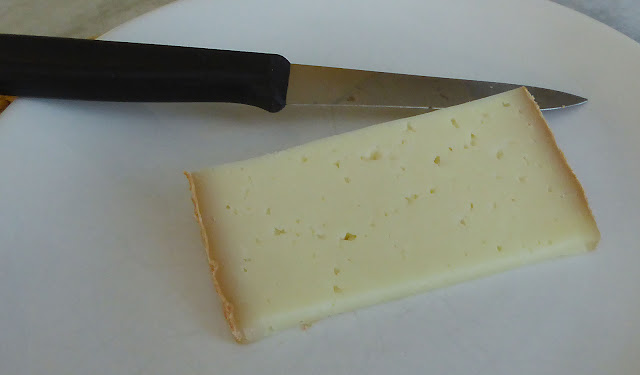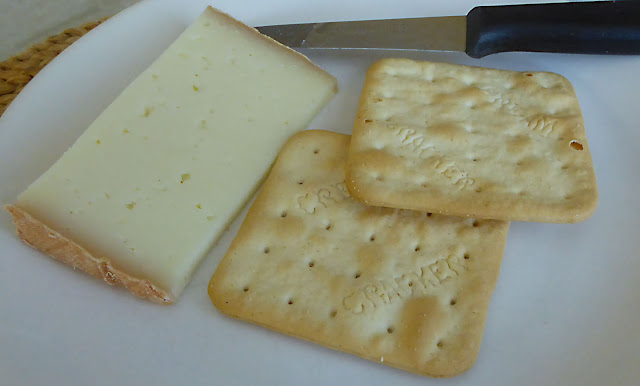It's raining! Walt just went out with Tasha to let her do her business and reports that it is pouring right now. I hope the rain lasts all day. It wasn't raining when I went outside with Tasha at five o'clock.
Lately, for eating and cooking, we've been enjoying sheep's milk cheeses from the Pyrénées mountains, about 300 miles south of Saint-Aignan. They're available in the supermarkets. The best-known such cheese is called Ossau-Iraty [oh-so-ee-rah-TEE] and has carried the AOC quality label since 1980. The production zone touches the Spanish border — its eastern edge is a beech forest called the Forêt d'Iraty, and the western edge is the deep Vallée d'Ossau.
Under AOC (and now AOP, a similar European label) rules, Ossau-Iraty cheese must be made with milk from flocks of sheep in a strictly defined area in the Pyrénées that corresponds roughly with the département des Pyrénées-Atlantiques, a territory about 85 miles from east to west and 55 miles from north to south.
By the way, the word brebis [bruh-BEE] in title of this post is the French word for "ewe" (a female sheep).
By the way, the word brebis [bruh-BEE] in title of this post is the French word for "ewe" (a female sheep).
The biggest, best-known towns in the département are Bayonne, Biarritz, St-Jean-de-Luz on the coast in Basque Country, along with Pau and St-Jean-Pied-de-Port up in the mountains. Back in the 1970s, local people saw that traditional cheese production on farms where sheep were kept was in danger of being taken over my industrial dairies. They organized a campaign to define strict rules and methods for the production of ewe's-milk cheeses and earned the AOC label. Nowadays, Ossau Iraty cheese can be made by farmers or in local dairies with either raw or pasteurized sheep milk. It's a mild (not "stinky") semi-hard cheese with a natural rind. The milk is not heated up ("cooked") during the cheese-making process.
In the late 1800s and well into the 20th century, industrial dairies specializing in making Roquefort cheese, which is also made with sheep's milk, set up plants in the western Pyrénées and started buying milk from local farmers. They would make a plain "white" cheese and then ship it by railroad to the caves 200 miles to the east at Roquefort for aging — it was turned into the blue cheese we all know so well. In the 1970s farmers in the Roquefort area developed new hybrid sheep varieties that produced milk in greater quantities. The Roquefort producers stopped buying as much lait de brebis in the western Pyrénées. The local farmers then turned to making the traditional sheep's milk cheese of their region, giving it the Ossau-Iraty name and standardizing production methods.





Ossa-Iraty is my favourite cheese, and I always get approving looks from fromageries when i ask for it in other countries. I miss the easy availability of it in supermarkets - by the time it gets to Australia, the price is many times higher. I generally preferred the Istara branded cheeses.
ReplyDeleteHello Mike, I was just reading about Istara. It's a local dairy/fromagerie that employs about 150 people and has a market share of 40% of all Ossau-Iraty produced in the AOP. Hope you're doing well.
DeleteHow is/are the dog(s)? Getting old as everybody else?
DeleteInteresting story about milk production. I had idea brebis' milk was "sheeped" from so far away to Roquefort!
ReplyDeleteYou might like this article about Roquefort and its cheese industry. Also, this web site about the history of Ossau-Iraty with many other links.
DeleteMerci des liens. Very informative.
DeleteIt has rain here, but it doesn't look like it was heavy. Not raining now, but I predict it will rain a lot today, especially at lunch time. That is because we are off to participate in a classic car event at which lunch is a picnic.
ReplyDeleteI was surprised to see how many cheeses were just called 'fromage de brebis' in the Pyrenees Atlantiques. Nobody seems to bother much about AOPs locally -- as usual, that's just for when you are sending your product to foreign parts. The most highly regarded cheese down there is a drum shaped one about 12cm in diameter. I can't remember its name, you eat it in thin slices with black cherry jam and it can be young and rubbery or old and crunchy.
I find the Saveurs range from SuperU consistently good. I've bought both those cheeses in your photo here in the past.
Would it be this drum-shaped cheese? It looks like the name on the label is Basquitou.
DeleteCould be that cheese -- I just can't remember.
DeleteWe've just come back from friends in Ste Maure -- 3 measly millimetres of rain so far!
If that's the St. Maure in the Loire, it's where my favorite (or one of my favorite) cheeses come from)-- St. Maure de Touraine. I don't think it's possible to buy it in the US any longer, so I buy it when we're in France and near the Loire.
DeleteSusan, I think the drum-shaped cheese you are describing is just called Le P'tit Basque, which is made from pasteurized ewe's milk and served with black cherry preserves.
DeleteWe had some rain at mid-day, but not a deluge.
I want to try that cheese sometime. So glad you're getting some rain today.
ReplyDeleteWe've stayed in the Basque region a couple of times, and had plenty of sheep cheese, Ossau-Iraty as well as non-AOP cheeses from very small producers. Always outstanding.
ReplyDeleteAgreed. Outstanding cheeses. We had Ossau-Iraty with fresh local figs at lunchtime today.
DeleteI always love this kind of information. I wonder if "regular" French people (=born and grew up there), as a rule, know this kind of background (as in, it would be passed down through conversations around the dinner table), or if they largely don't?
ReplyDeleteI don't think most French people know a lot about the different wine grapes grown in different regions, or all the different regional cheeses. I'm kind of a food and cooking nerd.
DeleteKen, a truer statement was never made...-:)
DeleteBased on my experience in France, you're certainly right Ken. I believe that to the average French person, wine is just a beverage to have with meals, and cheese is for a cheese platter after the main part of the meal. And if they know much about wine, it's usually just the wine of their region. We have a good friend who's lived most of her life in southern Burgundy. When her husband was alive, he made trips to the Beaujolais and probably other parts of Burgundy to buy wine, and she rarely went with him. After his death, the first time we went on an excursion with her, we first had lunch in Macon, and then drove to a couple of Burgundy and Beaujolais producers. At lunch we had a St. Veran, and at one of the places we stopped at we tasted a St. Veran. Although it was not the same producer, our friend said to the woman at the winery that we had just had their wine in Macon. I guess she must have thought that St. Veran was like a brand name for the producer. The other womanu seemed puzzled, and said that we must have eaten at the Chinese restaurant in Macon. But we hadn't.
DeleteGlad you posted the phonetics to Ossau-Iraty. I wouldn't have known how to pronounce it otherwise. I'm guessing this is something we'll not find in the States. You could do your own cooking show: "Les Carnets de Ken."
ReplyDeleteOkay by me, Ken! I must be an all-encompassing nerd because I love this kind of information. When I hear about something I like that I am unaware of the details, I just really, really start researching it to learn as much as I can about it! Keep up the great work! My daughter just returned from 21 days in France and she spent time this year in Brittany but I might have been able to request a package of one of those cheeses as my gift!
ReplyDeleteMary in Oregon